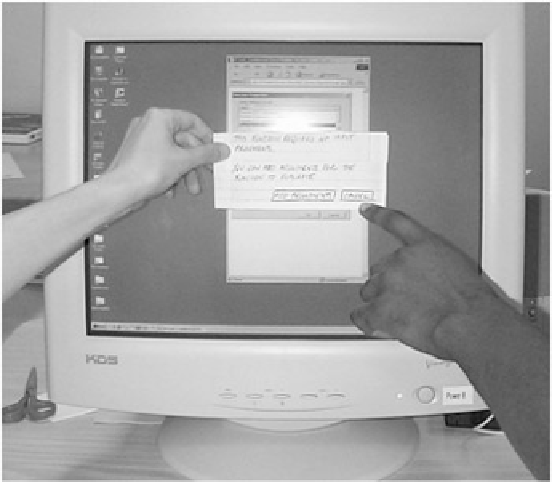Database Reference
In-Depth Information
Hybrid (Paper + Software) Testing
If you're having trouble deciding, why not take the best of both worlds? When a design is new or is
being overhauled, it probably makes sense to do all your prototyping with the same method. But
sometimes, especially if you've already done some usability testing, there may just be isolated parts of
the design that you're working on. You may want to consider a hybrid prototype, where you use the real
interface for most of the tasks but switch to paper for a screen or two as needed. (If you're up for a bit
of Wizard of Oz, have the users write inputs on the paper. Then you can ask them to close their eyes
while you "magically" replicate their actions in the software and then have them open their eyes and
continue testing with the software.)
Figure 14.1
shows an example where a single paper prototype
screen is held in front of a computer screen; it's also possible to put a few paper prototype screens on
the table next to the user.
Figure 14.1:
When you have only isolated screens to test, you can use a hybrid approach of
software and paper.
Hybrid prototyping may not be the best choice for companies that are just getting started with usability
testing. The hybrid approach is somewhat awkward when the paper prototype consists of more than a
couple screens or you do a lot of switching back and forth. I once conducted a usability study of a Web
application where we alternated each task between a paper prototype and a laptop. This worked
reasonably well, but the logistics were complicated—when users were working on the laptop, we also
had it projected on the wall so that the rest of the team could see. When we switched to the paper
prototype, however, we had to turn off the projector, move the laptop aside, and rearrange our seating.
We lost some test time due to the constant shuffling of people and equipment, although the users didn't
seem to mind.
I would use the hybrid approach again, but I would first make sure that it was truly needed, in other
words, that there was a set of questions that called for each method. Otherwise I'd probably vote for
doing the whole prototype one way or the other—in this case, the problems we found from testing on
the laptop would also have shown up in a paper prototype.














Search WWH ::

Custom Search